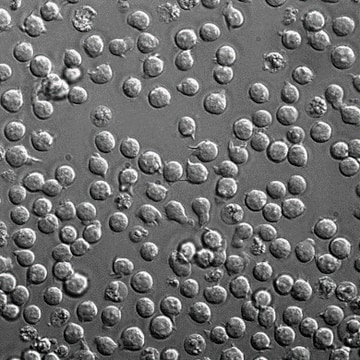CLL1219
Safe Harbor Landing Pad Cell Line A375 Cancer Cells
human female skin (Source Disease: Malignant melanoma)
Sign Into View Organizational & Contract Pricing
All Photos(1)
About This Item
UNSPSC Code:
41106514
NACRES:
NA.81
Recommended Products
product name
Safe Harbor Landing Pad Cell Line A375 Cancer Cells,
biological source
human female skin (Source Disease: Malignant melanoma)
Quality Level
growth mode
Adherent
technique(s)
cell culture | mammalian: suitable
shipped in
dry ice
storage temp.
−196°C
General description
The STR profile of this cell line matches that of its parental cell line ATCC® Catalog No. CRL-1619. A375 are a human malignant melanoma cell line isolated from a 54 year old female. The cells possess a hypotriploid karyotype.
Cell Line Description
These cells are a human malignant melanoma cell line isolated from a 54-year old female. The cells possess a hypotriploid karyotype.
Application
This product is a human A375 melanoma cell line in which a landing pad cassette has been integrated into the AAVS1 safe harbor locus using CompoZr® Zinc Finger Nuclease technology. The mKATE2 fluorescence gene was integrated following the EF1a promoter and flanked by unique Cre-lox sites. The design of this landing pad cassette allows for easy, fast, and affordable genetic modification using Cre recombinase. mKATE2 can easily be exchanged for a payload of the user′s choice using Cre recombinase and a targeting vector with appropriate lox sites. Cells can then be sorted via fluorescence-activated cell sorting (FACS) for loss of mKATE2 expression as a surrogate for successful integration of the targeting vector. Approximately 7-10 days are required for loss of the mKATE2 signal in successfully targeted cells. See technical bulletin for detailed protocols.
Features and Benefits
These cells contain the mKATE2 fluorescence gene flanked by unique Cre-lox sites inserted in the AAVS1 safe harbor gene. These A375 cells are adherent with a doubling time of approximately 22 hours.
Quality
Tested for Mycoplasma, bacterial and fungal content, post-freeze viability, short terminal repeat (STR) analysis for cell line identification.
Culture Medium
DMEM (Catalog Number D6429) with 10% FBS (Catalog Number F2442)
Legal Information
ATCC is a registered trademark of American Type Culture Collection
CompoZr is a registered trademark of Merck KGaA, Darmstadt, Germany
Storage Class
10 - Combustible liquids
wgk_germany
WGK 3
flash_point_f
Not applicable
flash_point_c
Not applicable
Certificates of Analysis (COA)
Search for Certificates of Analysis (COA) by entering the products Lot/Batch Number. Lot and Batch Numbers can be found on a product’s label following the words ‘Lot’ or ‘Batch’.
Already Own This Product?
Find documentation for the products that you have recently purchased in the Document Library.
Huseyin Tas et al.
PloS one, 10(9), e0136963-e0136963 (2015-09-04)
We describe an optimized system for the easy, effective, and precise modification of the Escherichia coli genome. Genome changes are introduced first through the integration of a 1.3 kbp Landing Pad consisting of a gene conferring resistance to tetracycline (tetA)
Zhong-Wei Du et al.
Stem cells (Dayton, Ohio), 27(5), 1032-1041 (2009-05-06)
To circumvent the silencing effect of transgene expression in human embryonic stem cells (hESCs), we employed the Cre recombination-mediated cassette exchange strategy to target the silencing-resistant site in the genome. We have identified new loci that sustain transgene expression during
Kimi Araki et al.
Nucleic acids research, 30(19), e103-e103 (2002-10-05)
The Cre-lox system is an important tool for genetic manipulation. To promote integrative reactions, two strategies using mutant lox sites have been developed. One is the left element/right element (LE/RE)-mutant strategy and the other is the cassette exchange strategy using
Our team of scientists has experience in all areas of research including Life Science, Material Science, Chemical Synthesis, Chromatography, Analytical and many others.
Contact Technical Service







